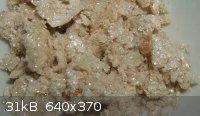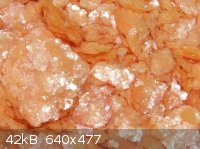| Pages:
1
2 |
Nicodem
Super Moderator
      
Posts: 4230
Registered: 28-12-2004
Member Is Offline
Mood: No Mood
|
|
I only checked the first patent and did not notice the isolation of the phenolate is described in the other one.
Just wash with brine instead of water or NaOH(aq).
|
|
|
leu
Hazard to Others
  
Posts: 368
Registered: 13-10-2005
Member Is Offline
Mood: No Mood
|
|
In the attached article, Synthetic Communications 9 (5) 407-410 (1979) by Press it's made by demethylation of
4-methoxyphenol by boron tribromide in methylene chloride in a 77% yield 
Attachment: 407-410.pdf (117kB)
This file has been downloaded 725 times
[Edited on 6-8-2012 by leu]
Chemistry is our Covalent Bond
|
|
|
no_dream
Harmless

Posts: 14
Registered: 15-8-2011
Member Is Offline
Mood: No Mood
|
|
Seems to work
The brine wash was a very good idea, thanks! The filtrates (400ml) were concentrated in vacuo to about 150ml. After cooling the whole crystallized in
small leaflet-like crystals. Now it was cooled in a ice bath. The crystal were stirred and then all was poured on a buchner. The filtration is slow.
Then a wash with ice cold saturated NaCl with a bit NaOH. The washing helps to remove the orange tint. But the orange liquid is very adhering to the
crystals and is removable only with multiple large washings, which leads to big losses. It was decided to wash only with about 80ml of the wash
solution. The crystal mass is very fine leaflets, which are essentially colorless, but orange because of the adhering mother liquor which is difficult
to remove. The pink-orange crystal mass was air dried on a sheet of paper.
After short drying, about 15g of still little moist crystals were dissolved in 50ml of hot water. A orange solution formed, with little white
precipitate, it was not clear. 10ml of conc. HCl added, an white emulsion formed. Ph went strong acidic. On cooling, a crystal mass formed. It was
vacuum filtered, washed with about 100ml of cold water and the result is 5,6g of moist white-light yellow crystals. The cresol smell is still present.
Recrystallized from water (30ml) with some drops of sulfuric acid. Some oily drops form at the bottom, which then forms darker crystals.
The result: 3,8g of moist tan crystals. Seems be pretty good soluble in water. Cresol smell remains, but is less intensive
Melting point about 115degC with discoloration. At about 110degC upwards the sample turned red-violet.
Conclusion:It seems the patent could work. But the distillation of the cresol feedstock is needed. I tried to avoid the distillation
because of the smell. The smell after this experiment is still persistent...
With dark cresol the byproducts are difficult to remove. After some refining this procedure could be workable and provide acceptable yields. The
biggest losses are in the washings.
EDIT: Pictures. One of the Na salt and other of the recrystallized product. It seems to be very crude and need further purification. But the losses
are enormous.
How commercial product looks like, can you send me a picture?
TLC was performed in ethyl acetate. The product rf is 0,636 - one round spot, comparative cresol 0,515 to 0,65. The cresol spot is oval and has an
streak reaching to the rf of product spot.
 
[Edited on 9-8-2012 by no_dream]
|
|
|
madcedar
Hazard to Others
  
Posts: 116
Registered: 10-9-2009
Member Is Offline
Mood: No Mood
|
|
I'm interested in seeing your pictures of the final product.
|
|
|
| Pages:
1
2 |